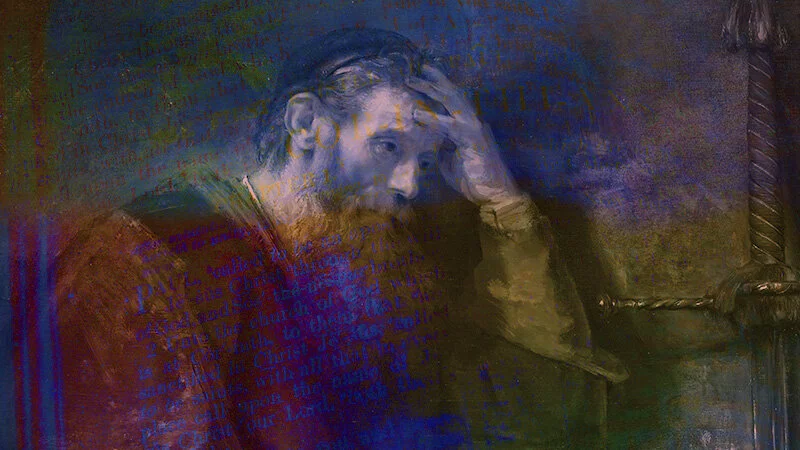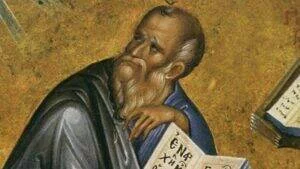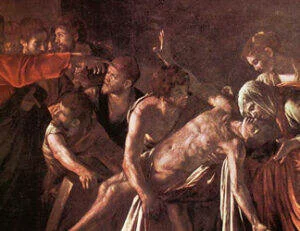For a man who died almost two millennia ago, the Apostle Paul is unusually polarizing. For some, Paul is the first and greatest theologian, the author of the “purest Gospel,” an apostle of a luminous and liberative grace.Martin Luther, Die Deutsche Bibel (Weimar: H. Böhlaus, 1931), 7:3.
At the seminary where I completed my master’s degree, the Paul we studied was a wise leader with a profound sensitivity for managing church conflict and community dynamics—in other words, the model pastor. (The number of conflicts that the apostle seems to have ignited during his lifetime does raise some questions about this.)
In other circles, however, Paul is cast as an antagonist, blamed for almost singlehandedly ruining Christianity before it even began by replacing the radical love and acceptance of Jesus with a number of distasteful strictures concerning women, sexuality, governing authorities, and suchlike. Worse, whatever sins the apostle failed to commit, his followers managed to carry through in his name. His letters have been used to support a litany of evils: “anti-Semitism, the oppression of women, the pogroms of dictators, and the expansion of neoliberal capitalism.”Cavan W. Concannon, Profaning Paul (Chicago: University of Chicago Press, 2021), 2.
Of course, passages from the apostle’s writings could be produced as evidence or counterevidence for any of these visions of Paul. To have been responsible for both founding and ruining “real” Christianity, for imposing hard-nosed legalism and for teaching radical grace, the apostle must have been a man of unusual profundity.
To have been responsible for both founding and ruining “real” Christianity, for imposing hard-nosed legalism and for teaching radical grace, the apostle must have been a man of unusual profundity.
The diverging characterizations of Paul point toward the difficulty of recovering the “real” Paul. The difficulties arise not only from the vast geographic and cultural oceans that separate us from the man but also from the fact that those who encountered him in his own day did not agree about him or his message either, as the apostle’s own letters testify. And yet there is something promising about the many different Pauls: perhaps he succeeded even more than he knew at being “all things to all people” (1 Cor 9:22).
If we were to consider each of these modern versions of Paul in depth, we would learn something not only about the apostle but about ourselves. The degree to which various details or interpretations are emphasized or ignored reveals something about the interests, anxieties, and purposes not only of Paul but of his readers as well. It is for this reason that a consideration of visions of Paul beyond our modern conceptions is particularly valuable: The modern Paul, in all his variety, is different yet again from the medieval Paul; and therefore considering the medieval Paul reveals additional dimensions of the apostle’s life and thought, suggesting new possibilities for our understanding of the apostle while simultaneously revealing the gaps and limitations of modern conceptions.
The medieval Paul was as variegated as the modern Paul, but in different ways. Karlfried Froehlich distinguishes the Paul of the New Testament epistles from the Paul of hagiography and legend, observing that the two were merged in late medieval Christian conceptions of the apostle.See Karlfried Froehlich, “Paul and the Late Middle Ages,” in A Companion to Paul in the Reformation, ed. R. Ward Holder (Leiden: Brill, 2009), 15–40. In other words, medieval Christians knew Paul not only as the author of the New Testament epistles, but also as he appeared in hagiographies—that is, as a saint, martyr, and mystic. Together, these visions of Paul produced a figure who was not simply the author of a particular set of contested theological teachings; rather, Paul was a Christian who had both suffered profoundly and tasted the sweetness of God.
Some aspects of this medieval Paul are familiar to readers today, while others are less so. The Golden Legend, a thirteenth-century collection of hagiographies (that is, saints’ lives) by Jacobus de Voragine that enjoyed enormous popularity in medieval Europe, gives a comprehensive portrait of Paul as he was seen through medieval eyes. The passage on Paul begins with six gifts that the apostle possessed: a fruitful tongue as evidenced by his preaching; a love of others and a desire to be in solidarity with them, as shown by his desire to identify with them (cf. 2 Cor 11:29); a wondrous conversion that manifested his election by God (cf. Acts 9:1–19); an industrious attitude toward labor, both physical and spiritual (cf. Acts 18:1–3; 1 Cor 4:12); the favor of mystical contemplation (cf. Acts 22:6–9, 17–18; 2 Cor 12:2–4); and virtuous humility. After this list of virtues, Jacobus paid particular attention to the many trials and persecutions endured by Paul, including beatings, imprisonment, an attempted stoning, conspiratorial plots, attacks by wild beasts, and snake bites. Jacobus also related Paul’s confrontation with the Emperor Nero, an episode that culminated in Paul’s martyrdom—but not before Paul converted the soldiers escorting him to his death. The Paul of The Golden Legend had suffered profoundly in both body and spirit. While Paul’s sufferings are by no means unknown today, Paul the theologian and letter-writer has largely overtaken Paul the martyr.
While Paul’s sufferings are by no means unknown today, Paul the theologian and letter-writer has largely overtaken Paul the martyr.
Another episode that especially fascinated medieval interpreters was the mysterious account of Paul’s rapture to the third heaven in 2 Corinthians 12:2–4. The apostle wrote:
I know a man in Christ, fourteen years ago (whether in the body, I do not know, or out of the body, I do not know – God knows), who was caught up to the third heaven. I know such a man (whether in the body or not, I do not know – God knows) that was caught up into paradise, and he heard secret words, which one is not permitted to utter.I have translated from the Vulgate, the Latin Bible used in the Middle Ages.
The account is enigmatic and lacking in detail, but medieval interpreters were certain of the identity of the unnamed man known to the apostle: it was Paul himself. Medieval interpreters believed that Paul concealed his identity in this account because of his great humility. The thirteenth-century exegete Hugh of Saint-Cher explained: “The Apostle speaks about himself as if about another when he recounts those things that pertain to his praise, but when he speaks about his sins, he speaks about himself as himself.”Hugh of Saint-Cher, Opera omnia in universum Vetus et Novum Testamentum (Venice: N. Pezzana, 1703), 7:142. Cf. Haimo of Auxerre, PL 117:660D (attributed to Haimo of Halberstadt). Many writers believed that this ascent to the third heaven took place during the apostle’s conversion on the road to Damascus, during which he neither saw nor ate nor drank for three days. For medieval readers, the Damascus episode was therefore not only an account of a miraculous conversion but also an account of mystical or visionary ecstasy.
Paul’s ecstatic and visionary experiences (cf. Acts 9:1–19, 22:1–18; 1 Cor 14:13–19; 2 Cor 12:2–4) were also believed to be the source and guarantor of his gospel. As Froehlich observes, medieval readers understood Paul’s claim that his gospel was not a human tradition (Gal 1:11–12) in a specific way: they understood the “mysteries of faith and hope” set forth in the apostle’s epistles to have been revealed to Paul in visionary contemplation.Froehlich, “Paul and the Late Middle Ages,” 31–32. Paul was also believed to have received other mystical teachings through his rapture to the third heaven, specifically the teachings passed down to his student, now known as Pseudo-Dionysius. Dionysius was believed to have recorded these teachings in his Mystical Theology, one of the most influential works of apophatic theology in the Christian tradition. Not only a saint and a martyr, Paul was also a mystic and mystagogue.
Not only a saint and a martyr, Paul was also a mystic and mystagogue.
The fifteenth-century biblical commentator Denis the Carthusian described what occurred during Paul’s ecstatic rapture to the third heaven, offering significantly more details than did the apostle himself. Although the biblical account relates only that Paul heard arcana verba [secret words], medieval Christians generally believed that Paul enjoyed a unitive vision of God while rapt to the third heaven. Thus, to explain the “secret words” that Paul heard, Denis wrote: “With God having spoken in his soul through internal illumination, Paul perceived and knew certain secrets about God and creatures, particularly about the mysteries of Christ, about divine predestination, about the orders of angels, and many other things, the knowledge of which exceeded all natural knowledge.”Denis the Carthusian, In omnis beati Pauli epistolas commentaria, in Opera omnia, in unum corpus digesta ad fidem editionum Coloniensium cura et labore monachorum sacri ordinis Cartusiensis favente Pont. Max. Leone XIII, vol. 13 (Montreuil: Typis Cartusiae S. M. De Pratis, 1901), 254. Denis explained that even after the rapture, “certain similitudes” of the marvelous things Paul had seen remained in his mind so that he could instruct the church in the mysteries of the faith.
While some medieval writers maintained that Paul’s rapture either could not or should not be directly imitated by other, lesser Christians, other medieval writers took Paul as an exemplar of mystical ascent and used his rapture as a biblical precedent for their own mystical contemplation. In the anonymously authored Life of Beatrice of Nazareth, the hagiographer used Paul’s ascent to the third heaven to explain Beatrice’s own ecstatic rapture. Beatrice, who was born near the beginning of the thirteenth century, lived among the Beguines before becoming a Cistercian nun and later prioress of the convent of Nazareth. One day, while listening to the mass, Beatrice felt herself to be pierced through the soul with a flaming sword. The Lord assured Beatrice that he had “especially chosen her” and written her name in the Book of Life.Roger De Ganck, trans., The Life of Beatrice of Nazareth (Kalamazoo, MI: Cistercian Publications, 1991), 201. The author then continued:
Paul is described as caught up to the third heaven: Beatrice is spiritually raised by the divine spirit to the choir of Seraphim. . . . I dare not make Beatrice’s merits equal to those of the most blessed prince of the apostles, Paul, who labored more than all, who was suddenly made a vessel of election and marked out by the Lord as the teacher of the Gentiles, although he could rightly have been rejected by God as a persecutor and blasphemer. But, I would say, and not rashly I think, that the mode of vision was not unlike in each case, especially as achieved by the same Spirit and accomplished in about the same order.De Ganck, Life of Beatrice, 205–207.
The author of the hagiography assured his readers that Beatrice saw God in the fullness of his essence during this rapture, using Paul’s ascent as proof that those who were very holy could enjoy such a unitive vision prior to death.
Other late medieval writers drew their inspiration from the fact that Paul mentioned three heavens. Medieval writers loved to produce triads, and the three heavens offered the potential for tripartite allegories in which each heaven represented a stage or mode of mystical contemplation. One of the most intricate of these allegories appears in the English anchoress Julian of Norwich’s Showings. The Showings were a record and interpretation of a set of visions that Julian had received during a near-death illness in 1373. In the ninth vision, Julian recounted being lifted into heaven, where she saw three heavens, at which sight she “greatly marveled.”Edmund Colledge and James Walsh, eds., A Book of Showings to the Anchoress Julian of Norwich (Pontifical Institute of Mediaeval Studies, 1978), LT ch. 22. I have modernized the spelling and language for ease of reading. Julian went further than the Apostle Paul, however, in that she described what she saw in the three heavens.
According to Julian, the three heavens were three modes of contemplating Christ’s humanity by considering its relation to each of the three Persons of the Trinity. In the first heaven, one contemplated the Father’s properties and works as exemplified in the pleasure taken by the Father in the deeds performed by Christ for humanity’s salvation. In the second heaven, one contemplated the Son’s endless love for humanity, as exemplified in his suffering on their behalf. In the third heaven, one contemplated the Holy Spirit’s endless delight in the Son’s Passion. These three heavens and their program of christologically inflected contemplation of the Trinity were all equally fruitful: “None is more, none is less, none is higher, none is lower, but all alike in bliss.”Showings, LT chs. 22–23. Like Paul, Julian’s readers could ascend through contemplation to the mysteries of the Trinity.
What would it be like to read Paul today as medieval Christians did? The Anglo-Catholic scholar of mysticism Evelyn Underhill is one of the few twentieth-century theologians to see Paul through medieval eyes. She wrote: “Christian literature begins with a handful of letters written by a mystic.”Evelyn Underhill, Essential Writings, ed. Emilie Griffin (Maryknoll, NY: Orbis, 2003), 59. Medieval writers would have used the word contemplative rather than mystic (since the latter word did not yet exist), and they did not have the benefit of modern biblical studies to tell them that Paul’s epistles were written prior to the gospels, but they would have agreed with Underhill in spirit. Blending the insights of modern biblical scholarship with her own contemplative insights, Underhill continued: “This means that the earliest documentary witness to Jesus Christ which we possess is the witness of mysticism; and it tells us not about His [Christ’s] earthly life, but about the intense and transfiguring experience of His continued presence, enjoyed by one who had never known Him in the flesh.”Underhill, Essential Writing, 59-60. Underhill saw what it would mean to configure the scriptural data about Paul as medieval readers did, bringing his contemplative and visionary experiences to the fore. The result is a Paul who not only wrote about God’s presence but also tasted it.








Comments
Be the first one to make a comment!